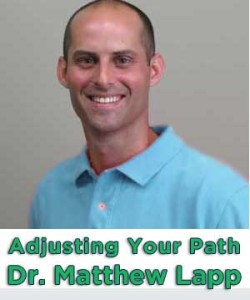Health and well-being spring from your spinal column
By Dr. Matthew Lapp, Columnist, The Times
 The summer months are a time of great activity and celebration. It’s also a time when many people begin an exercise routine or take a closer look at their fitness goals. And, since the spine is the foundation for almost all activity, it’s important to understand and recognize some of the most important gifts that our spinal structures have to offer.
The summer months are a time of great activity and celebration. It’s also a time when many people begin an exercise routine or take a closer look at their fitness goals. And, since the spine is the foundation for almost all activity, it’s important to understand and recognize some of the most important gifts that our spinal structures have to offer.
So, as you read through some of these concepts, keep in mind the question “what level of function do you want for your body and your life?” You might be surprised at how closely related spinal health and your overall quality of life actually are.
The first gift of the spine is function. As we mentioned earlier, almost all physical movements are generated by the spinal structures and the single biggest physical stress on the spine comes from the use of the arms and legs. Therefore, it’s important to make sure that all of the components of the spine, including the muscles, the bones, the ligaments, discs and the neural control system are functioning optimally.
For example, a 2003 study performed at Akita University in Japan found that, when compared with factors including spinal fractures, spinal angles and spinal range of motion, spinal range of motion had the highest correlation with quality of life. Furthermore, they found that spinal mobility has a high influence on overall quality of life. Other studies have shown that individuals with higher functioning spinal health actually have more joy and happiness, less risk of falls, and lower rates of mortality.
The second gift is the ability to convey and experience emotion. Have you ever seen someone slumped over in a chair or sulking towards you and thought, “that person must be having a great day!”? Of course not; you would probably think that they were depressed, angry or sad. On the other hand, standing up straight with the shoulders back and the spine in alignment has the ability to create an appearance of inner strength and happiness.
Over the years, artists have used a sharp spinal angle to create the effect of anger and the appearance of a curved spine to indicate joy. Additionally, research from John’s Hopkins actually showed that the the highest concentration of the chemicals that signal our emotions, called neuropeptides, were actually found in an area of the spinal cord. The next time you feel tired or upset, try changing your posture and notice the effect it has on your whole demeanor. Or, the next time you’re experiencing profound joy, try rounding the shoulders and slumping forward. It’s almost impossible.
The third gift of the spine is a sense of self. Each of us has a “story” of who we are in the world. This story dictates how we interact with those around us, how we view ourselves in comparison to our community, and the actions and behaviors we engage in as we live our lives. If you’ve ever heard the phrase, “in the back of my mind” then you should also realize that the spinal cord is the literal extension of the brain and mind. Therefore, whether joyous or painful, a life event can be stored in the mind and actually transferred to the physiology of the body based on the influence of the spinal structures. Furthermore, a life filled with excitement, love, and gratitude can have a profound influence on how we see ourselves, as well as how we outwardly express those inner feelings.
The next gift is behavior. Or, more specifically, access to and awareness of our behavior, as well as the ability to change it rapidly. Just as our inner story is largely generated by the implications and meaning that we give to our experiences, our behavior is an external representation of the story. As, we mentioned earlier, you can sometimes create a new internal feeling (happiness, sadness, anger, etc) by changing the external structure of your posture. Thus, we can apply this knowledge and actually create behaviors that work for us, as opposed to against us simply by changing the structure of our body, are agreements with others, or some other external structure.
The final gift of the spine is consciousness. Put simply, consciousness is awareness, and awareness is paying attention. By paying attention to our body, we are able to develop a greater sense of internal awareness. By paying attention to our emotions, we’ll become more in touch with them. If you want to experience spiritual enlightenment, start paying attention to the wonder that is all around us. No matter where you put your attention, you’re bound to create a greater awareness and understanding of it.
As is the case with any new activity, practice, or skill it’s important to take your time and recognize that lasting change doesn’t usually happen over night. If spinal health and fitness is a new concept to you, start slowly as you begin to celebrate the gifts that the spine has to offer.
Drs. Allison and Matthew Lapp are the owners of Salus Chiropractic Studio in Thorndale. For more information, visit them on the web at http://www.thorndalechiropractor.com/







Outstanding article, Dr. Lapp! Chiropractic is a very safe, effective, targeted treatment that impacts our quality of life and so much more. We only have one spine and we need to take care of it! When we actually notice these reduced ranges of motion and pain(s) the problem has been there for a while. Get checked and get adjusted if necessary and life a much happier, healthier life! Thanks for the great article!
You’re right John! It’s about so much more than pain and symptoms, it’s about your quality of life! Thanks for your comment.
My physical therapist said while standing or sitting imagine you are pulling up on a string attached to your head. If you do that you can feel a weight lifting from your body. It’s really your entire body lining up correctly and supporting the weight of your head without strain.
Thanks for your comment Jim! I agree, as your body comes into better alignment, it’s actually easier to move, range of motion improves, and you may actually feel your mood improve.